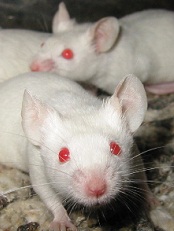
Photo by Aaron Logan
Researchers have created a patch designed to monitor a patient’s blood and release heparin as needed to prevent thrombosis.
In mice, the patch successfully released heparin into the bloodstream and proved more effective at preventing thrombosis than an injection of heparin.
Zhen Gu, PhD, of the University of North Carolina at Chapel Hill, and his colleagues developed the patch and described it in Advanced Materials.
“Our goal was to generate a patch that can monitor a patient’s blood and release additional drugs when necessary; effectively, a self-regulating system,” Dr Gu said.
The patch incorporates microneedles made of a polymer that consists of hyaluronic acid (HA) and the drug heparin. The polymer has been modified to be responsive to thrombin.
When elevated levels of thrombin enzymes in the bloodstream come into contact with the microneedle, the enzymes break the amino acid chains that bind the heparin to the HA, releasing the heparin into the bloodstream.
“The more thrombin there is in the bloodstream, the more heparin is needed to reduce clotting,” said study author Yuqi Zhang, a PhD student in Dr Gu’s lab. “So we created a disposable patch in which the more thrombin there is in the bloodstream, the more heparin is released.”
“We will further enhance the loading amount of drug in the patch,” said study author Jicheng Yu, a PhD student in Dr Gu’s lab.
“The amount of heparin in a patch can be tailored to a patient’s specific needs and replaced daily, or less often, as needed. But the amount of heparin being released into the patient at any given moment will be determined by the thrombin levels in the patient’s blood.”
Experiments in mice
The researchers tested the patch in a mouse model of thrombosis. The mice were injected with large doses of thrombin (1000 U kg-1) to induce an acute thromboembolism, which can lead to death in about 92% of mice.
The mice were then randomized into 5 different treatment groups:
- Intravenous heparin injection
- Empty HA microneedle patch
- HA microneedle patch encapsulating free heparin
- Thrombin-responsive HA-heparin microneedle patch
- Non-responsive HA-heparin microneedle patch (heparin dose: 200 U kg−1).
The mice that received heparin via injection were treated before thrombosis induction. The microneedle patches were applied to the dorsum skin of the mice 10 minutes before the challenge.
All of the mice with the HA microneedle patch or the non-responsive HA-heparin microneedle patch died within 15 minutes of the thrombin injection.
All of the mice that received the heparin injection, heparin microneedle patch, or the thrombin-responsive HA-heparin microneedle patch survived the 15 minutes.
In a second experiment, mice received a thrombin injection 6 hours after treatment, and treatment consisted of:
- Heparin injection
- HA microneedle patch encapsulating free heparin
- Thrombin-responsive HA-heparin microneedle patch.
Fifteen minutes after the thrombin injection, death had occurred in 80% or more of the mice that received the heparin injection and the mice treated with the heparin microneedle patch.
But all of the mice treated with the thrombin-responsive HA-heparin microneedle patch survived.
The researchers also noted that staining of lung sections revealed the “superior anticoagulant capacity” of the thrombin-responsive HA-heparin microneedle patch.
The team observed “insignificant differences” in the lungs of healthy mice and mice treated with the thrombin-responsive HA-heparin microneedle patch.
However, mice that received a heparin injection or treatment with the heparin microneedle patch had intravascular and interstitial hemorrhage, blocked blood vessels, and atelectasis.
“We’re excited about the possibility of using a closed-loop, self-regulating smart patch to help treat a condition that affects thousands of people every year, while hopefully also driving down treatment costs,” Dr Gu said. “This paper represents a good first step, and we’re now looking for funding to perform additional preclinical testing.”


